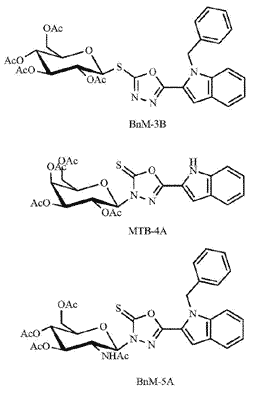Abstract
The inhibition of glycosidases from bacteria and the liver of normal and diabetic rats by 2-(tetra-O-acetyl-β-Dglucopyranosylsulfanyl)- 5-(1-benzyl-1H-indol-2-yl)-1,3,4-oxadiazole BnM-3B; 3-(2,3,4,6-tetra-O-acetyl-β-D-galactopyranosyl)- 5-(1H-indol-2-yl)-1,3,4-oxadiazole- 2(3H)-thione MTB-4A; 3-(2-acetamido-3,4,6-tri-O-acetyl-2-deoxy-β-Dglucopyranosyl)- 5-(1-benzyl-1H-indol-2-yl)-1,3,4-oxadiazole-2(3H)-thione BnN-5A has been investigated. In vitro treatment of hepatic α-amylase and β-glucuronidase from control and streptozotocin-induced diabetic rats by S- and Nglycosyl analogues from oxadiazolinethione derivatives exhibited a significant dose-dependent decrease on the specific activity of both α-amylase and β-glucuronidase. Moreover, these compounds also exhibited a significant decrease on the specific activity of α-amylase and α-glucosidase produced by Bacillus subtilis AH. The observed IC50 values of these compounds are much lower than that of ethanolamines, higher for α-glucosidase than α-amylase from bacteria and significantly lower for hepatic α-amylase and β-glucuronidase from diabetic rats. The obtained results suggest that these compounds are good inhibitors that act on glycosidases from bacteria and normal / diabetic rats in different mechanisms.
Keywords: Enzyme inhibitors, ethanolamines, glycosidases, glycosyl-sulfanyl-oxadiazole, oxadiazolinethione.






























